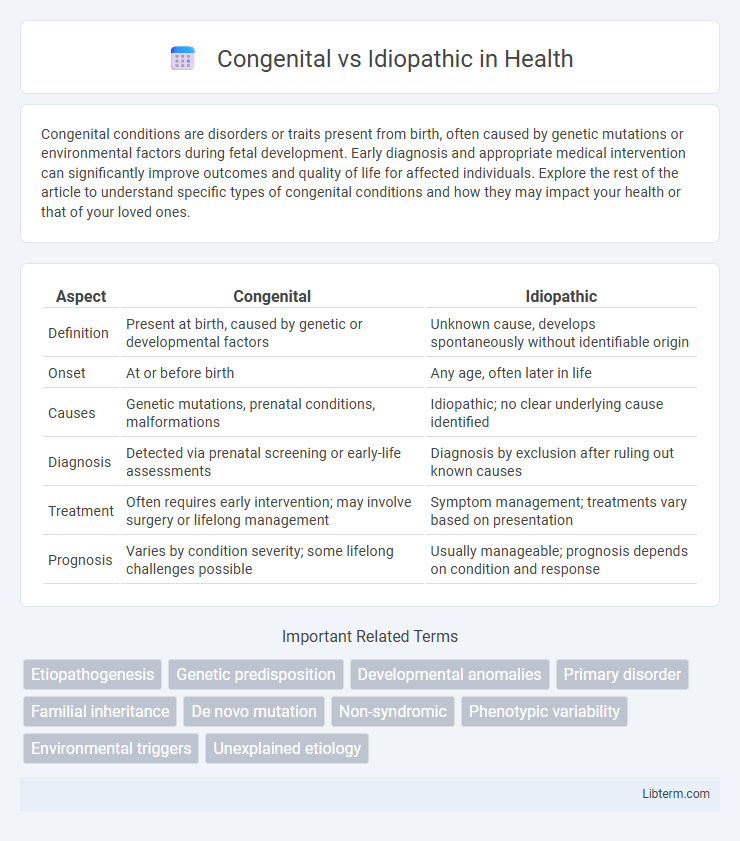Congenital conditions are disorders or traits present from birth, often caused by genetic mutations or environmental factors during fetal development. Early diagnosis and appropriate medical intervention can significantly improve outcomes and quality of life for affected individuals. Explore the rest of the article to understand specific types of congenital conditions and how they may impact your health or that of your loved ones.
Table of Comparison
| Aspect | Congenital | Idiopathic |
|---|---|---|
| Definition | Present at birth, caused by genetic or developmental factors | Unknown cause, develops spontaneously without identifiable origin |
| Onset | At or before birth | Any age, often later in life |
| Causes | Genetic mutations, prenatal conditions, malformations | Idiopathic; no clear underlying cause identified |
| Diagnosis | Detected via prenatal screening or early-life assessments | Diagnosis by exclusion after ruling out known causes |
| Treatment | Often requires early intervention; may involve surgery or lifelong management | Symptom management; treatments vary based on presentation |
| Prognosis | Varies by condition severity; some lifelong challenges possible | Usually manageable; prognosis depends on condition and response |
Introduction to Congenital and Idiopathic Conditions
Congenital conditions are disorders or abnormalities present from birth, resulting from genetic factors, environmental influences, or developmental issues during pregnancy. Idiopathic conditions have unknown causes, often diagnosed after excluding other potential factors, reflecting a lack of identifiable etiology. Understanding the distinction between congenital and idiopathic conditions is crucial for accurate diagnosis, treatment planning, and patient management.
Defining Congenital Disorders
Congenital disorders are medical conditions present from birth, often caused by genetic mutations, environmental factors during pregnancy, or chromosomal abnormalities. These disorders differ from idiopathic conditions, which have unknown causes and typically develop later in life without identifiable genetic or environmental triggers. Understanding congenital disorders involves recognizing their origin in prenatal development, which is crucial for diagnosis, treatment, and genetic counseling.
Understanding Idiopathic Conditions
Idiopathic conditions refer to diseases or disorders with unknown causes, distinguishing them from congenital conditions, which are present at birth due to genetic or developmental factors. Understanding idiopathic conditions involves extensive research, including clinical studies and advanced diagnostic techniques, to identify underlying mechanisms despite the lack of clear etiology. Improved knowledge of idiopathic diseases aids in developing targeted treatments and personalized medical approaches, enhancing patient outcomes despite the initial uncertainty in diagnosis.
Key Differences: Congenital vs Idiopathic
Congenital conditions are present at birth and result from genetic abnormalities, developmental issues, or environmental influences during fetal development. Idiopathic conditions have no identifiable cause, often diagnosed through exclusion after thorough medical evaluation. The key difference lies in congenital origin being detectable from birth, whereas idiopathic causes remain unknown despite investigations.
Causes and Risk Factors
Congenital conditions arise from genetic mutations, chromosomal abnormalities, or prenatal environmental exposures, such as maternal infections, drug use, or nutritional deficiencies during pregnancy. Idiopathic conditions have unknown or poorly understood causes, with risk factors often inferred from epidemiological patterns, including age, lifestyle, and environmental influences. Genetic predispositions, family history, and prenatal factors are key contributors in congenital disorders, while idiopathic cases may involve complex interactions of multiple risk factors without a single identifiable origin.
Diagnostic Approaches
Diagnostic approaches for congenital conditions often involve detailed prenatal imaging techniques such as ultrasound and fetal MRI, alongside genetic testing to identify specific chromosomal abnormalities or gene mutations. Idiopathic diagnoses rely heavily on exclusion methods, where all known causes are systematically ruled out through comprehensive clinical evaluation, laboratory tests, and imaging studies. Advanced molecular diagnostics, including whole-exome sequencing, play a critical role in differentiating idiopathic cases from undiagnosed congenital disorders.
Common Examples of Each Type
Congenital conditions such as congenital heart defects, cleft lip and palate, and spina bifida are present from birth due to genetic or environmental factors during fetal development. Idiopathic diseases like idiopathic pulmonary fibrosis, idiopathic thrombocytopenic purpura, and idiopathic scoliosis have unknown causes despite thorough medical evaluation. Understanding these examples helps in distinguishing inherited or developmental origins from conditions with unclear etiology.
Implications for Treatment and Management
Congenital conditions often require early intervention and tailored treatment plans due to their developmental origins, which may include genetic counseling and specialized therapies. Idiopathic disorders, lacking a known cause, typically demand symptom-focused management strategies and ongoing monitoring to adapt treatments as the condition evolves. Understanding the distinct etiologies informs the clinical approach, influencing prognosis and therapeutic decisions.
Prognosis and Long-Term Outcomes
Congenital conditions are present from birth and often have a known genetic or developmental cause, influencing prognosis based on the severity and early intervention, with some disorders showing stable or improving long-term outcomes. Idiopathic conditions, having no identifiable cause, can present challenges in prognosis due to unpredictable disease progression and response to treatment, often requiring ongoing management and monitoring. Long-term outcomes vary widely between congenital and idiopathic cases, with congenital diseases sometimes benefiting from early diagnosis and tailored therapies, while idiopathic disorders may exhibit fluctuating courses impacting quality of life.
Summary and Future Directions
Congenital conditions arise from genetic or developmental anomalies present at birth, while idiopathic disorders have unknown causes despite thorough investigation. Advances in genomic technologies and biomarker discovery hold promise for unraveling idiopathic disease mechanisms, enabling personalized treatment strategies. Future research will likely emphasize integrating multi-omics data with clinical phenotyping to improve diagnostic precision and therapeutic outcomes.
Congenital Infographic

 libterm.com
libterm.com